In this article, you will learn What is Gear & How it works? Its Working, Applications, Types of gears, and Different Types of Gear Trains.
You can also download the PDF file at the bottom of the article.
What is a Gear?
When there’s a gear problem everything can come to a stop because of this you need to understand how gears work to keep them working in their associated equipment operating.
Gear can be defined as a toothed wheel that can be engaged in another toothed wheel to transmit energy that gives the change of speed and direction of motion. It is widely used in mechanical devices. The teeth of the gear are generally carved on wheels, cylinders, or cones.
Many devices that we use in our day-to-day lives have their working principle. The tooth and wheel of the gear are working parts of all types of gear. The different types of gears are used to complete the transfer of energy in different ways and different directions.
A gear is a component within a transmission device that transmits the rotational force to another gear or device. Gear is different from a pulley in that a gear is a wheel that has teeth that mesh with other gear teeth. Allowing the force to be fully transferred without slippage.
Depending on their construction and arrangement, geared devices can transmit forces at different speeds, torques, or in a different direction, from the power source.
The most common situation is for a gear to mesh with another gear. To overcome the problem of slippage as in belt drives, gears are used which produce a positive drive with uniform angular velocity.
Checkout: What is Gear Terminology? Basic Terms Used In Gear & Calculation
Types of Gears
Following are the important types of gears:
- Spur gear
- Helical gear
- Double helical gear
- Bevel gear
- Spiral bevel gear
- Screw gear
- Mitre gear
- Worm gear
- Internal gear
- External gear
- Rack and pinion gear
- Herringbone gear
- Hypoid gear
- Sprocket
- Epicyclic gear
- Involute spines
- Straight sides splines
Read also: Chain Drives and Types Of Chains
#1 Spur Gear
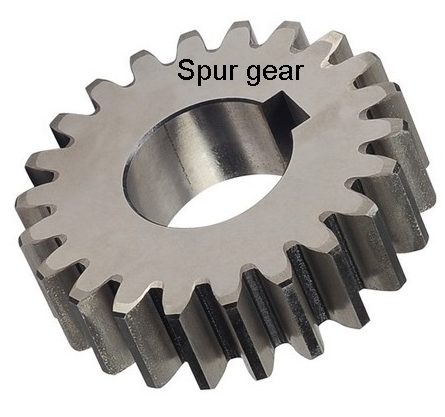
The spur gear is the most common and simplest type of gear. It is generally used for the transmission of rotary motion between parallel shafts. The spur gear is the best option for gears except when speed, loads, and ratios direct towards other options.
They have straight teeth and are mounted on parallel shafts. Their general form is a cylinder or disk. The teeth project radially and with these “straight-cut gears”. When two spur gears of different sizes mesh together, the larger gear is called a wheel, and the smaller gear is called a pinion.
In a simple gear train of two spur gears, the input motion and force are applied to the driver gear. The driver gear rotates the driven gear without slipping.
#2 Helical Gear
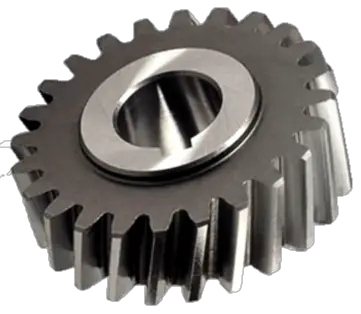
Helical gears offer a refinement over spur gears. The teeth of a helical gear are not parallel to the axis of rotation but are set at a helix angle. Helical gears can be meshed in a parallel or crossed orientation.
Along with parallel helical gear, each pair of teeth first contacts one point on the one side of the gear wheel. A moving curve of contact increases gradually against the teeth’ face to a maximum then comes back until the teeth reach contact at one point on the opposite side.
Because of the angled teeth of helical gear, they reduce the noise and stress in the gears, most of the gears in your car are helical. The use of helical gears is indicated when the application involves high speeds, large power transmissions, or where no noise is important.
#3 Double Helical Gear
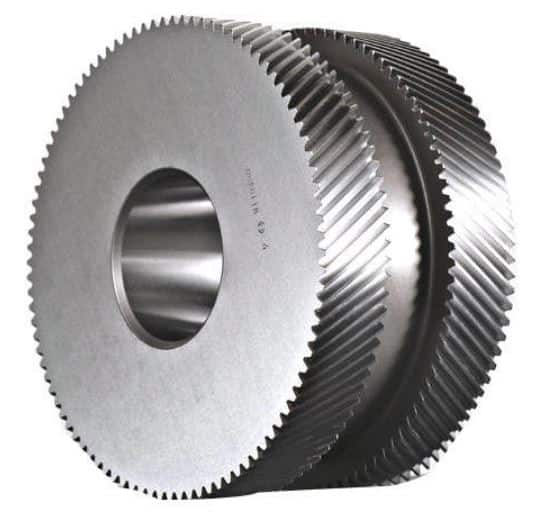
A double helical gear is a type of helical gear that has right and left-hand teeth on a single gear. It consists of two faces of helical gears placed next to each other and separating them from each other. This type of gear is very similar to herringbone gear in appearance.
Double-helical gears will eliminate thrust load and allow for more significant tooth overlap and smooth operation. In addition, it provides an additional shear area on the gears which is necessary for further high-torque transmission. Like helical gears, these gears are commonly used in enclosed gear drives.
#4 Bevel Gear
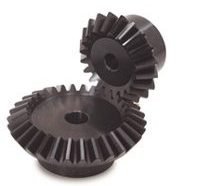
Bevel gears have teeth cut on a cone instead of a cylinder blank. they are used in pairs to transmit rotary motion and torque where the bevel gear shafts are at right angles (90 degrees) to each other. When two bevel gear have their axes at right angles and are equal sizes, they are called miter gears.
The bevel gear transmits power between two intersecting shafts at any angle or non-intersecting shaft. they are classified as straight and spiral tooth bevel and hypoid gears. These are gears cut from conical blanks and connect intersecting shaft axes.
The connecting shaft is generally at 90°and sometimes one shaft drives a bevel gear which is mounted through the shaft resulting in two output shafts. The point of intersection of the shaft is called the apex and the teeth of the two gears converge at the apex.
Bevel gears come in two categories:
- Straight Teeth Bevel Gear: A straight teeth bevel gear has tapers both in tooth thickness and length.
- Spiral Teeth Bevel Gear: Spiral teeth bevel gears have diagonally arranged teeth. Spiral bevel gears are more powerful and less noisy than straight bevel gears. Alternatively, they are known as skew bevel gear.
Read also: Transmission Of Power By Rope Drive and [Types of Ropes]
#5 Spiral Bevel Gear
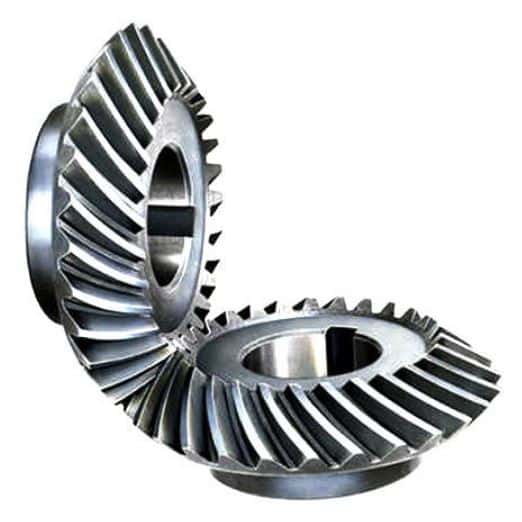
These are curved tooth-lined bevel gears. These are considered superior to straight bevel gears in efficiency, strength, vibration, and noise due to the high contact ratio but are challenging to produce.
Since it has curved teeth, they cause a thrusting force in the axial direction. The zero turning angle in a spiral bevel gear is called zero bevel gear. These gears are known for high-torque and high-speed applications and require little maintenance.
#6 Screw Gear
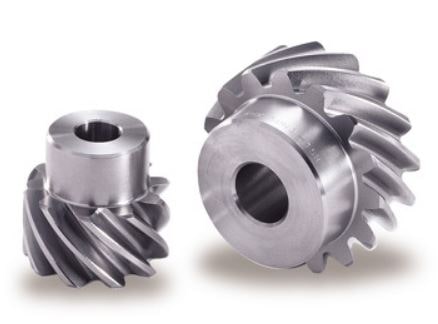
Screw gears are a pair of same-arm helical gears with a turning angle of 45° on a non-parallel shaft. Also known as crossed helical gears, they are mostly used in motion transmission between non-transfer shafts.
Since the tooth contact is a single point, their load-carrying capacity is low, and they are not suitable for large power transmissions. These gears require lubrication when power is transmitted through sliding tooth surfaces. Screw gears are typically employed for offset shafts.
Read Also: Different Types of Bearings and Their Uses [PDF]
#7 Mitre Gear
It is a particular bevel gear designed to operate in pairs with the same number of teeth, diameter pitches, and 1:1 ratio. These are used to change the direction of power transmission without changing the speed. These are available in straight miter and spiral miter gears.
Thrust bearings are essentially used with spiral miter gears because they generate thrust force in an axial direction. In addition to the standard miter gear with a 90° angle shaft, a miter gear with any other shaft angle is called an angular miter gear.
#8 Worm Gear
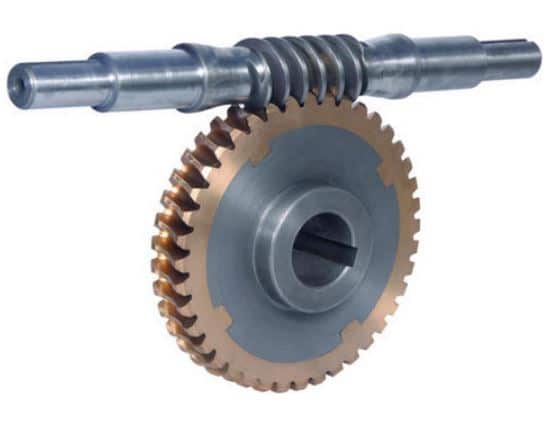
The arrangement of gears shown in the image is called a worm and worm wheel. The two elements are called the worm screw and worm wheel.
A gear that has one tooth is called a worm wheel. The tooth in the form of a screw thread is called a worm screw. The worm wheel is a helical gear with teeth inclined so that they can engage with the thread-like worm.
This wheel transmits torque and rotary motion through a right angle. The worm can easily turn the gear, but the gear cannot turn the worm. This is because the angle on the worm is so shallow that the gear tries to spin it. Worm mechanisms are very quiet running.
It is used to transmit power between the driving shaft having their axes at right angles and non-coplanar as shown in Fig. Worm gears are used in machine tools when large gear reductions are needed.
It is common for worm gears to have reductions of 20:1, and even up to 300:1 or greater. This feature is useful for machines such as conveyor systems, in which the locking feature can act as a brake for the conveyor when the motor is not turning.
#9 Internal Gear
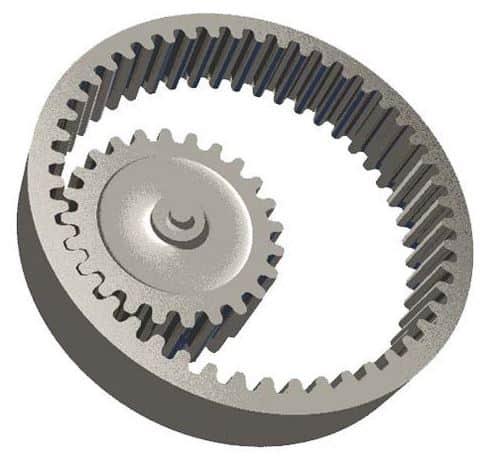
In this type of gear, the inner gear has teeth cut on the inside of the cylinder and paired with the outer gear. Internal gears are mainly used for planetary gear drives and gear-type shaft couplings.
There is a disadvantage with this gear, which is the uneven number of internal and external gears due to trimming problems and interference such as the trochoid and involute. The internal and external gears in the mesh have the exact rotational directions while they are opposite when the two external gears are in the mesh.
#10 External Gears
An external gear is a gear that has its teeth made outside of a cylinder or cone. When a pair of external gears mesh, the rotational direction of the external gears is reversed. External gears (spur gears) are always used in conjunction with internal gears.
#11 Rack and Pinion Gear
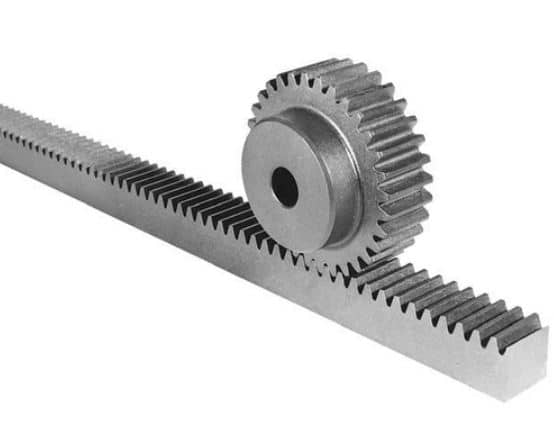
A rack and pinion is a pair of gears that convert rotational motion into linear motion and vice versa. A circular gear called “the pinion” engages teeth on a linear “gear” bar called “the rack”.
Rotational motion applied to the pinion will cause the rack to move to the side, up to the limit of its travel. The diameter of the gear determines the speed that the rack moves as the pinion turns.
A rack and pinion are commonly found in the steering mechanism of cars or other wheeled, steered vehicles. In a rack railway, the rotation of a pinion mounted on a locomotive or a railcar engages a rack between the rails and pulls a train along a steep slope, machine tools such as a lathe machine, drilling machine, and planning machine.
#12 Herringbone Gear
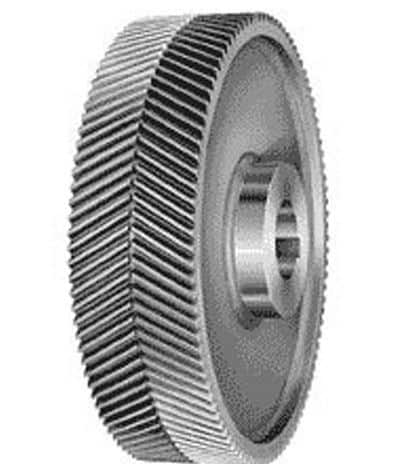
Herringbone gears are similar to double-helical gears but do not have a gap separating the two helical faces. From above, each helical groove of this gear resembles the letter V, and several together form a herringbone pattern (fish bones like herring).
Despite helical gears, these gears do not generate an additional axial load. These are typically smaller than the double-helical gear and ideally suited for high shock and vibration applications. These types of gears are not used very often due to their manufacturing difficulties and high cost.
#13 Hypoid Gear
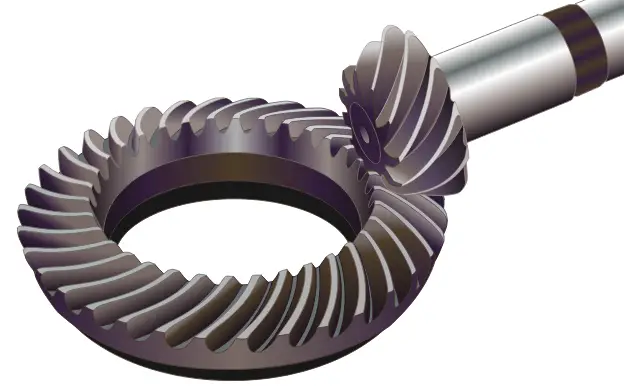
Hypoid gear looks like spiral bevel gear in some respects. For example, hypoid gears are shaped like spiral bevel gears and high points are used on cross-axis shafts like bevel gear sets are.
But unlike bevel gear sets the shafts of hypoid gears do not line up with each other they’re offset. This offset allows hypoid pinions to have as few as five teeth in a high ratio gear set while the various types of bevel gears typically don’t have less than 10 teeth in pinion.
The smaller number of teeth on a hypoid pinion means that larger ratios can be obtained with a hypoid gear set than with a bevel gear set of the same dimensions.
You might like: Different Types of Thread Taps and Their Uses
#15 Epicyclic Gear
It is made up of two gears that are mounted so that the centers of both gears rotate around one another. In other words, one or more gear axes move in epicyclic gearing. Mechanical differentials and sun and planet gearing are two examples of epicyclic gears.
You might like: Different Types of Screwdrivers with Their Uses
Types of Gear Trains
A gear train is a mechanical system formed by mounting gears on a frame. As mentioned above, when two or more gears mesh together to transmit power from one shaft to another such arrangement is called a gear set or a gear train.
Sometimes two or more gears are made to mesh with each other to transmit power from one shaft to another such a combination is called the “gear train of the wheel”.
Also, each gear is generally attached to a shaft often gears that are meshed together will be of different sizes, in this case, the smaller gear is referred to as the pinion, and the larger one is simply referred to as the gear.
Following are the different types of gear trains:
- Simple gear trains
- Compound gear trains
- Reverted gear trains
- Epicyclic gear trains
#1 Simple Gear Trains
In these types of gear trains, the distance between the two wheels is great the motion from one wheel to another is transmitted by providing one or more intermediate wheels as shown in the figure.
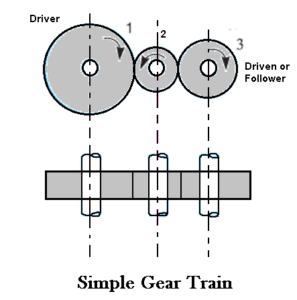
When the number of intermediate wheels is odd, the motion of the driver and follower is as shown in the figure. If the number of intermediate wheels is even the motion of the follower will be in the opposite direction of the driver as shown in the figure.
#2 Compound Gear Train
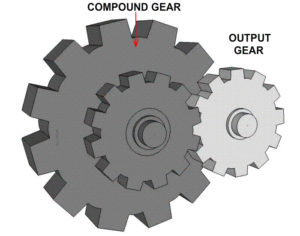
In a compound gear train, each intermediate shaft has two wheels fixed to it. These wheels have the same speed. One wheel gears with the drier and the other wheel gears with the follower attached to the next shaft.
#3 Reverted Gear Trains
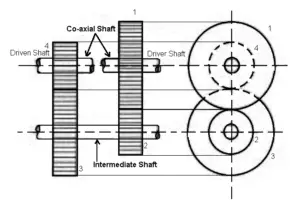
When the axes of the first and last wheels are co-axial the train is known as a “reverted gear train” as shown in Fig. Since the motion of the first and last wheel is alike, therefore a compound wheel is provided. Since the distance between the centers of the shaft, 1 and 2 as well as 3 and 4 is the same.
#4 Epicyclic Gear Train
In an epicyclic gear train, the axes of the shaft, over which the gears are mounted, move relative to a fixed axis. A simple epicyclic or planetary gear train is shown in the figure.
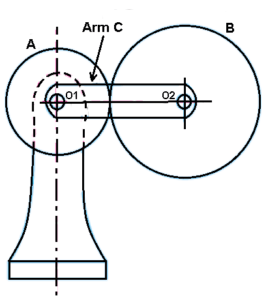
Here wheel A and arm C have a common axis at O1 about which they can rotate. Wheel B meshes with wheel A and has its axis on the arm at O2, about which wheel B can rotate. If wheel A is fixed and the arm is rotated, the train becomes an “epicyclic gear train”.
Advantages of Gears
The following are the advantages of gears:
- Gears are mechanically strong, they can carry higher loads easily.
- They are used to transmit motion over shafts with small center distances.
- These mechanical devices are capable of transmitting large high frequency (H.F.).
- Gears only need to be greased, therefore maintenance is minimal.
- Gear systems allow us to transfer motion across non-parallel intersecting shafts.
- Because of its long lifespan, the gear system is extremely compact.
Disadvantages of Gears
The following are the disadvantages of gears:
- Gear systems are not suitable for high-speed operation.
- They are poor at transmitting motion over long distances.
- Some noise may come from the operating gear.
- The engagement of toothed gear wheels under heavy loading might cause irreversible damage to some machine elements.
Download the PDF of this article:
Wrapping It Up
In the end, I conclude that each type of gear has a similar function, which is to transmit power from horizontal to vertical and to change the speed of an object.
Now, I hope I’ve covered everything you were looking for about “types of gears“. If you still have any doubts or questions regarding this topic, leave a comment below I’ll reply. If you like it, then share this with your friends.
Want free PDFs direct to your inbox? Then subscribe to our newsletter.
Read Next:
Great post! I learned so much about the different types of gears and their specific applications. It’s fascinating to see how each type contributes to various machinery. The PDF resource is super helpful for future reference. Thanks for sharing!
Glad you found the post helpful!
Nice explanation tutorial thank you
You’re welcome.
Though am not a mechanical engineering professional, I really enjoy reading your articles. The illustrations using clear diagram easily drives the point home!
Thanks for your feedback.
I have liked it🥰🥰
Thanks for reading.
Thanks
You’re welcome.
I like every post
Thanks for reading our articles.
Thanks